| Fictional info (?) |
|---|
| Suggested name | Saiet-iosut |
| Planet type | Cold planet |
| As seen relative to the fixed stars, it rotates on its axis exactly five times for every two revolutions it makes around Kepler-585.
.
A prominent result is the "great orange spot", a giant storm that is known to have existed for centuries since it was first observed by radar. |
| Atmosphere | Krypton | 50% |
| Carbon monoxide | 42% |
| Argon | 8.1% |
| Atmospheric pressure | 25 bar |
 |
| Moon | Arathea Hedra | Small irregular gaseous moon |
| Sarok | Large round gaseous comet |
| Berok | Medium-sized slightly egg-shaped gaseous asteroid |
| Berlade-pan | Huge almost round rocky moon |
| Porie Lind | Medium-sized almost round rocky comet |
| Melyke Rasda | Large potato shaped oceanic moon |
| Disteph | Huge almost round rocky asteroid |
| Jotnomia Ste | Large almost round gaseous planetoid |
| Tebos Cha | Medium-sized potato shaped gaseous asteroid |
| Tierher | Very small slightly egg-shaped oceanic asteroid |
| Ijidita Pa | Small irregular rocky asteroid |
| Ariso Pidpe Anda | Medium-sized slightly egg-shaped ice planetoid |
| Topid | Small round rocky planetoid |
| Panke | Huge potato shaped gaseous moon |
| Paahi | Medium-sized round ice moon |
| Setelene | Very small potato shaped oceanic asteroid |
| Girarathi | Very small round rocky comet |
| Hetay-menomas The | Medium-sized almost round ice asteroid |
| Skanytus Ada | Small potato shaped rocky planetoid |
| Fennis-kape-teus | Medium-sized almost round gaseous asteroid |
| Liapan | Small potato shaped rocky comet |
| Noemar Dil | Huge irregular rocky moon |
| Ijihar-gelpaa | Huge slightly egg-shaped ice asteroid |
| Lissie Hyanis | Large round oceanic comet |
| Bospsalene | Medium-sized round ice comet |
| Google search for Saiet-iosut |